London Pubs
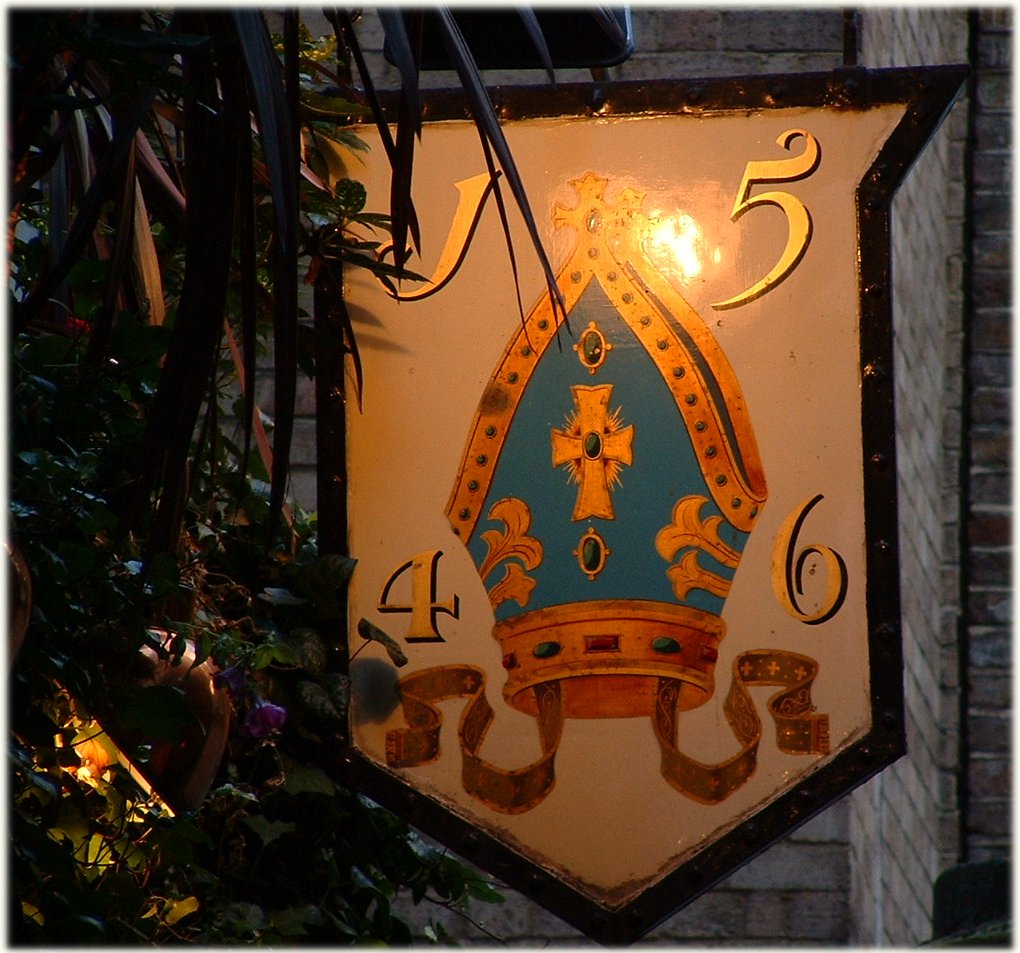

The Origins of the pub signs.
In 1393 King Richard II decreed that pubs must have signs so that the examiner or tester
of ales would know the location of each pub.
The pictorial sign was developed in the times when the vast majority of the population
were illiterate and needed something large, simple and bright to recognise.
 The Prospect of Whitby : 57 Wapping Wall E.1
The Prospect of Whitby : 57 Wapping Wall E.1
This historic pub built in 1520 during the reign of Henry VIII, when surrounded originally with empty fields. It was first called the Devil's Tavern, soon to be the haunt of smugglers and thieves, who sold bodies, washed up by the Thames to medical schools. In 1777, to improve its image, it changed the name to a locally moored ship the Prospect of Whitby, which transported Sea Coal from Newcastle to London. In 1780 a sailor, returning from the West Indies, sold the first ever Fuchsia in England for a quart of rum. Regular visitors to this riverside pub were Dickens, Turner and Whistler; also the artist Gustave Dore sketched his London low life from here.

There have been numerous sightings of ghosts said to be of highwaywoman Moll Cutpurse and the notorious Judge Jeffreys the hanging judge, who would look from an upstairs bay window whilst hangings took place at Execution Docks, fulfilling his sentences.
The stone floor which has been walked on for over 500 years has a trap door which has been sealed off for over a hundred and fifty years, Chris the manager said he would dearly love to open it to see what treasures it holds.
The bar has a long and winding pewter counter, which I believe is the only one left in the country.

The riverside view from the Prospect of Whitby with the reminder of the hanging gallows complete
with noose.
 Town of Ramsgate : 62 Wapping high Street E.1
Town of Ramsgate : 62 Wapping high Street E.1
Town of Ramsgate was known originally as the Red Cow; after a rather bad-tempered
red-head barmaid. its name came from the Kentish fishermen who landed their catch next
door at Wapping Old Stairs. From the balcony at low tide you can still see the post where
pirates were executed at Execution Dock, being made to stand on a plank with a rope
around their necks. The plank was tipped over, leaving the victims gasping for breath for
30 minutes. Still alive, they would then be cut down, squeezed into a metal gibbet, and
left to sink in the muddy river bank at low tide. After being submerged three times by the
incoming tide, and after an unpleasant death, they were left for the crows to pick at the
rotting human flesh through the bars of the cage. One famous pirate to die this way was
Captain Kidd, in 1701. As a superstar of the day he pulled a big crowd, among them an
ex-lover. Kidd growled: 'I have lain with that bitch three times, now she comes to see me
hanged'. The badly rusted harness was only rediscovered in the mud this century. During
the eighteenth century, the cellars of the pub were used as dungeons for convicts awaiting
transportation to America and Australia. There is also a nearby pub called 'The Captain
Kidd' after the famous execution.
The Widow's Son : 75 Devons Road, Bow E.3 
The widow’s son was due back in London on Good Friday and his mother had made some
hot cross buns to welcome him home to their cottage in Bow. He never did make it and
was never seen again. Every Easter she made a special bun, hoping for her son’s return.
She died in 1848 the widow had died, the cottage became a pub, taking the name 'The
Widow's Son' to remember a mother’s grief. The hot cross buns have still been coming
every Good Friday for the past 163 years and left hanging from the ceiling, some as hard
as iron. Every Good Friday, a Royal Navy sailor adds a new bun to the collection. Sailors
from around Britain come to pay their respects to the widow and her son. They hold a
religious service, then sing, drink and generally have a good time.
The Mayflower : 117 Rotherhithe Street, S.E.16 
Rotherhithe ship-owner Christopher Jones moored his ship outside this pub in 1620, when the pub was called the Shippe, in order to embark his passengers from the pub's jetty. Over three months later his human cargo disembarked at a place they christened Plymouth, New England; the passengers were the Puritan Pilgrim Fathers, the ship was The Mayflower and the colony they founded is now known as the United States of America.
One can only speculate whether the Pilgrim Fathers had a few swift beers in the Shippe before embarking on The Mayflower, as that would confirm the statement of whether 'The people who founded America must have been p****d!' On a less flippant note, it's worth considering what the World would be like today had The Mayflower floundered en-route.
Ye Olde Watling : Watling street, E.C.4

Watling Street, built by the Romans in perfectly straight sections and the first direct highway from the Kent Coast to North Wales. Watling Street’s route through the City of London is punctuated by St Paul’s Cathedral, which virtually blocks its path. In the shadow of the World’s second largest Dome, where Bow Lane intersects Watling Street, sits Ye Olde Watling. The pub was allegedly built by St Paul’s Architect, Sir Christopher Wren, to accommodate labourers building the cathedral and incorporates the timbers of old ships.
Williamson's Tavern : 1 Groveland Court, Off Bow Lane, London, EC4

Williamson's hotel dates back to the seventeenth century and is reportedly the pub with
the first excise license in the city of London. Dating back to just after the great fire of
London 1666, it was occupied by the Lord Mayors of London until 1753. The building
was then sold to Robert Williamson who turned it into a hotel. The wrought iron gates
were presented by William III and the tiles on the fireplace are Roman.
The Bleeding Heart Tavern : Bleeding Heart Yard, E.C.1
'A man in a velveteen coat,' Charles Dickens tells us, '[sits in the] parlour of a low public house...[
with]...a small glass, strongly impregnated with the smell of liquor'. The novel is
Oliver Twist, the 'public-house' is The Three Cripples and the drinker is Bill Sykes.
There's some debate upon which pub The Three Cripples is based; some suggest it's The
Bleeding Heart Tavern because Dickens knew it well, although he also knew many others
between Holborn and Clerkenwell. Dickens using Bleeding Heart Yard, the cobbled
courtyard behind the pub, as the Plomish family home in Little Dorrit, substantiates the
claim. In a tale more suited to Jack the Ripper is, apparently, how Bleeding Heart Yard
got its name. Hatton Garden, the nearby centre of the diamond trade, takes its name from
the Hatton family. The morning after a ball at the family house, Lady Elizabeth Hatton’s
disfigured body was found in the courtyard, the victim of a spurned lover, with her heart
'still pumping blood onto the cobblestones.'
The Mitre Tavern : Mitre court Hatton garden, E.C.1
There is a sense of real discovery when you find the Olde Mitre Tavern. It is hidden
down a small alleyway between numbers 8 to 9 Hatton Garden, marked by an old
crooked street lamp, and a small sign in the shape of a Bishop's Mitre. Many who work in
the area don't even know it exists. The original tavern was built in 1547 for the servants
of the palace of the Bishops of Ely, Cambridgeshire. Technically the tavern is still part of
Cambridgeshire and, until the last century, the pub’s license was issued from there. Even
the City police had no jurisdiction here. The Palace was built as the Bishops’ London
base and is the oldest Catholic church in London. They had power and riches and played
host to Henry VIII and Elizabeth I. After the Reformation, Elizabeth forced the bishops to
rent some of their lands to Sir Christopher Hatton, one of her courtiers. The area is now
known as Hatton Garden. Both palace and pub were demolished in 1772; however, the
pub was soon re-built. A stone mitre from the palace gatehouse is built into a wall, just
visible under the tumbling ivy. The preserved trunk of a cherry tree, which marked the
boundary of the diocese, is in the corner of the front bar. It is said Elizabeth I danced the
maypole around this tree.
The George : Wanstead High Street, E11 
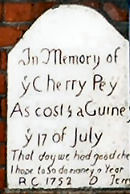
This pub has a 200 year old crime to boast. On the 17th July 1752, two workmen were up on scaffolding whilst below, a daily temptation passed in the form of a tray of the finest cakes from the next door bakery. They were carried overhead by the baker's boy and the workmen were tempted to reach out and steal one. On the 7th of July, they were caught red cherry handed; as the sign reads. 'Ye Cherry pey'.
That day we had good cheer Hope to do for many a year.
Hand and Shears : Cloth Fair E C 1
A pub has stood on this spot in Cloth Fair since the 12th century, in which was once a busy street where the Bartholomew Fair was held each year during the middle ages. Cattle would also pass through on their way to Smithfield Market. Nowadays full of charm and a quiet corner of hidden London. This pub was once owned by the Merchant Taylor's and so allowed to bare the Hand and Shears emblem. Historically a popular place for a quick drink before heading to Newgate Prison, to see the executions. The sign above the door reads "The last ale house before the Newgate executions."
The Viaduct Tavern : 126 Newgate Street, E C 1

The Viaduct Tavern is built on the site of the Giltspur Street Compter, a sheriff's prison demolished in 1855. In the cellar of this Victorian pub are the cells for holding the rogues of the day. As the pub name suggests, The Viaduct Tavern is named after the nearby Holborn Viaduct, both the pub and Viaduct were opened by Queen Victoria in 1869. This event was presumably one of the few of Queen Victoria's last public engagements, as Prince Albert had died eight years earlier and Victoria's 'retirement' from public life - in mourning - is well documented.
See the cells
here
Dirty Dicks : 202 Bishopsgate, E C 1
Nathaniel Bentley was an ironmonger who had a shop in Leadenhall Street.
On the eve of his wedding, tragedy struck. His bride-to-be died. So distraught was Nathaniel that he locked up the room in which he had prepared the wedding feast, never to enter it again.
A broken man, he neither washed or changed his clothes. When his cats died he just left them.
The English love an eccentric and his notoriety meant his business flourished. When Nathaniel retired in 1804, the landlord of the Old Port Wine Shop in Bishopsgate, bought the contents lock, stock including dead cats. He put them on display at his pub and renamed it 'Dirty Dick's'.
In 1870 the pub was rebuilt from ground level, the wine vaults are part of the original building. The 'dirty' contents were carefully relocated in the new pub.
Sadly it was decided in the mid-nineteen-eighties that a clean up was in order and the dirty artefacts were cleared away.
The Anchor : 34 Bankside, Southwark, S.E.1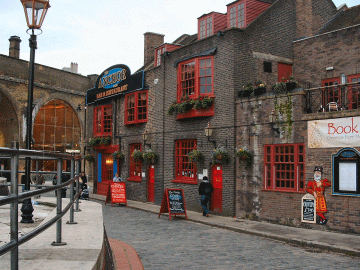
It was from this pub that Samuel Pepys witnessed the awesome destruction of the Great Fire of London in 1666. He describes the dreadful heat and "fire drops" falling on him whilst in a boat on the river. He sought refuge in "a little alehouse on Bankside and there watched the fire grow".
The Anchor was rebuilt in 1676 after the fire devastated the area.
The pub's original structure has been added to over several centuries, creating a maze of odd little rooms featuring old brick fireplaces, waney oak beams and worn, creaking floorboards.
There are several interesting bars, one named after Dr Johnson, lexicographer and writer, who drank here regularly. A copy of his dictionary is on display.
The main dining room has wonderful views across the Thames to the City. Another, the Shakespeare Room (used for functions), has beautiful 18th-century pine panelling. A first-floor terrace and riverside terrace offer outdoor seating.
The George Inn : Borough high street, S.E.1
The brewery's literature calls The George Inn 'The last remaining galleried coaching inn in London'. The George was rebuilt in 1676, after a devastating fire swept Southwark.
It was one of many such inns in the area, perhaps the most famous being the Tabard, where Chaucer began his Canterbury Tales in 1388.
The Tabard too was rebuilt after the fire but was demolished in the late 19th century, despite a public outcry.
The George also narrowly avoided total destruction. Charles Dickens used The George Inn as the setting for a few the scenes in his novels, and apparently, Shakespeare himself acted in the courtyard.
The Queen's Larder : 1 Queens Square, W C 1
George III stayed at the nearby home of Dr Willis during his first bout of 'madness', caused by prophyria, a rare metabolic disorder.
The illness first struck the King in1788 with symptoms that shocked the court, he was caught talking to a tree, and even worse attacked his son during dinner at Windsor Castle.
His treatment at Queens Square was often humiliating and horrific. George was tied down to an iron chair and disgusting remedies were smeared over his body.
During the King's confinement at Queens Square, his wife, Queen Charlotte, stored delicacies for her husband in the cellar of this pub.
Jerusalem Tavern : Britton Street, E.C.1

The Jerusalem Tavern with the side passage where Thomas Britten played his concerts.
The Jerusalem Tavern on Britton Street, takes its name from the Priory of St. John of Jerusalem, that was founded in 1140 on this very ground.
The Tavern has occupied several sites in the same area during the past six hundred years or so. The present building dates from 1720 - although not as a pub, it was originally a watchmakers shop. Britton Street takes its name from an incredible coalman of the late 17th century, Thomas Britton. Britton who walked the streets by day in a blue frock, and with his small coal-measure in his hand. People would call out "there goes the small coalman, who is a lover of learning, a performer in music, and a companion for gentlemen." By night he gave concerts by the side of the original Jerusalem Tavern in Jerusalem Passage. He was a fine opera singer and was frequently accompanied on the harpsichord by no less than Mr Handel. Wooden tables and alcoves add to the charm of the Jerusalem Tavern, settle back and forget the outside world for a bit.
The Red Lion : Colchester Street Aldgate E.1

The site of the Red Lion during demolition work
Now nothing more than a cloud of dust, though we are more interested in the history of this demolished pub than what the beers were like, so even though this public house no longer exists its history lives on.
In the year 1738 the legendary highwayman Dick Turpin stole from a farmer in Epping a mare called white stockings and stabled her here at the Red Lion. When his fellow highwayman Tom King came to fetch her, the constable also arrived. There was a struggle, and Dick Turpin cried out “Shoot, Tom or they’ll get us”. but in the confusion Turpin shot King, who died almost immediately. Behind a glass case in this pub from then until it closed its doors for the last time, about ten years ago, was an old signboard illustrating the incident, with a key to the stable where “White Stockings” was concealed.
Crown and Two Chairmen: 31-32 Dean Street, W1Named after two sedan chair-bearers that dropped by as they took Queen Anne to have her portrait painted opposite. Karl Marx, the great 19th century socialist thinker and communist lived next door to the Crown & Two Chairmen during his "long, sleepless night of exile, and may well have had a quick half there.
The Cockpit Tavern : 7 St Andrews Hill, EC4

Up stairs viewing Gallery of the Cockpit Tavern
Built on the site of William Shakespeare’s house in Blackfriars is the Cockpit Tavern. This pub was once also a cockfighting arena. Once inside the round pub area and you are actually on the cockfighting floor. Looking upwards you can still see the tiny gallery where the people would gather to watch the fighting as our picture above shows. In the cellars of this public house, now used for beer barrel storage are the rooms that were once part of the Blackfriars Monastery. As this pub is off the beaten tourist track it is an out of the way location. It is one of the only pubs in this area that opens on Sunday, so go along for a quiet drink it's well worth the effort.

Outside view of the Cockpit Tavern
Morpeth Arms : Millbank

The Morpeth Arms overlooking the River Thames and sited on part of the old Millbank Prison, with a prisoners ghost to boast of. It was a prisoner who died shortly before his transportation to Australia he lurks beneath the bar in part of the old prison that still remains today.

The barman checking out the old prison cells for the ghost.
The BlackFriar : 176 Queen Victoria Street
Watercolour by William Eales
This pub stands on the site of Blackfriars monastery, built in 1221 demolished in 1538. The pub was built in 1904 and contains a large monk laughing above the entrance to the pub. Contains many illustrations of monks and friars. Fragments of some monastery wall were built around Shakespeare's Playhouse theatre in Ireland yard and are still there today.
Masons Arms : Maddox Street W.1
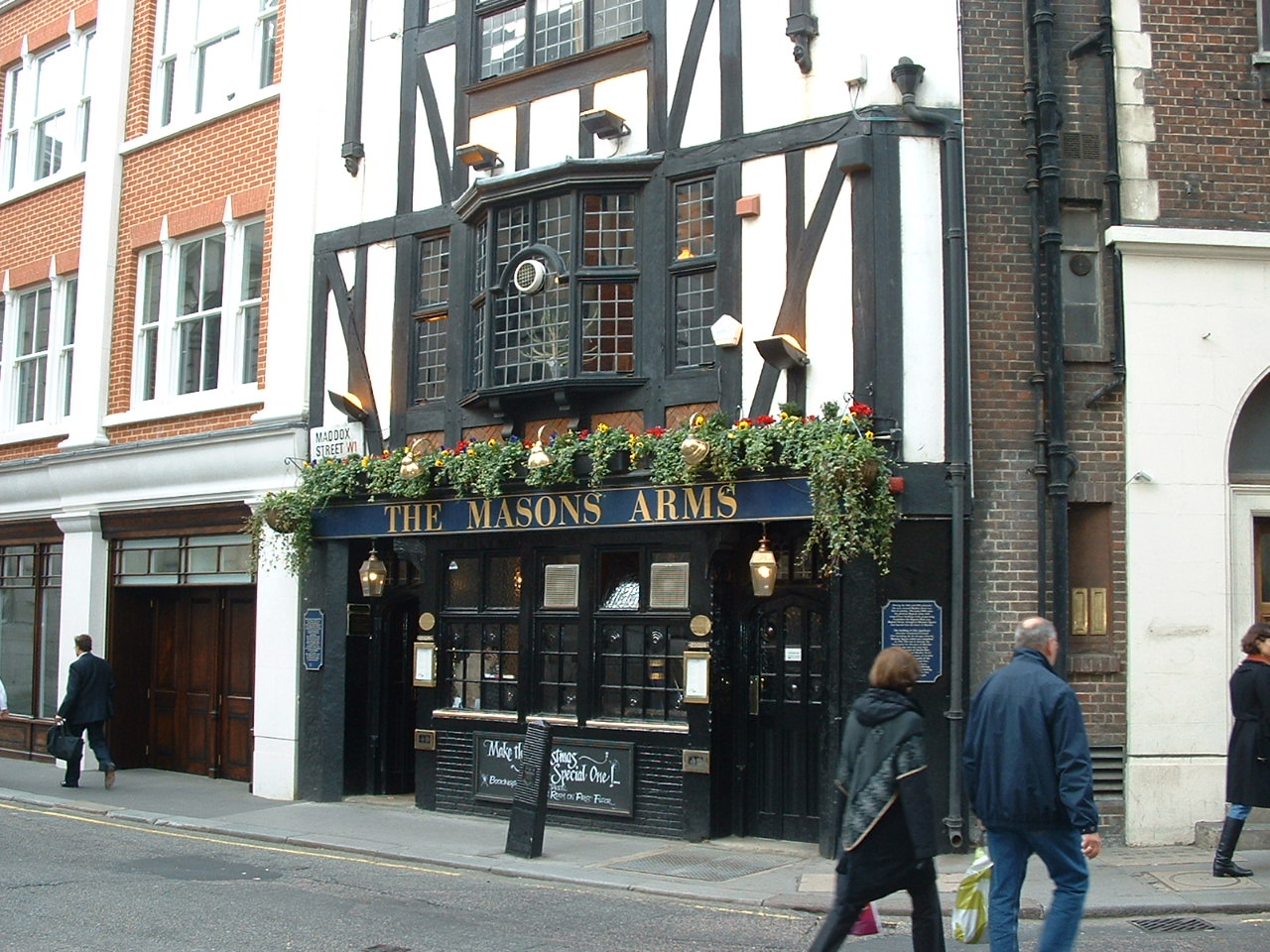
The first records of the Masons Arms were as a tailors shop in the 1800's. In the year of 1851, William Lelong opened it up as a hairdressers salon. In 1858 he passed the ownership to Mrs Charlotte Ward who turned the shop into a public House and called it the Masons Arms in recognition of the stonemasons who were busy in the development of this part of Mayfair. It has remained the Masons Arms ever since.
The Grenadier pub : Wilton Row S.W.1
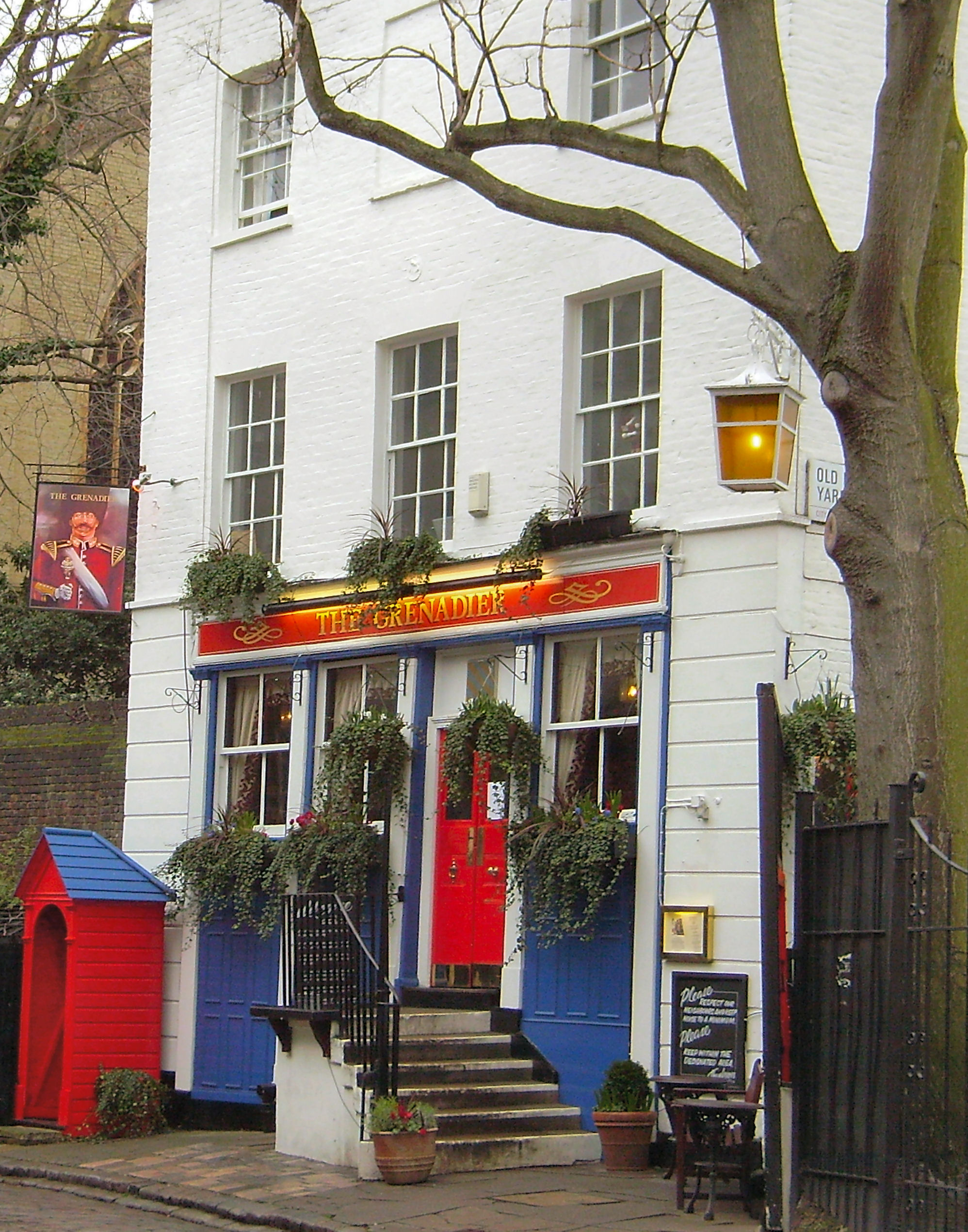
Wilton Place, built in 1872 on the site of a cow yard will lead you from Knightsbridge to Wilton Crescent and then into the hard to find Wilton Row. This delightful mews was once part of the barracks of the Duke of Wellington’s guards,
the Iron Duke who lived a short distance away at Apsley house,
better known as number one London. The old officer’s mess now houses the Grenadier Pub,
along with the patriotic red, white and blue décor and the grenadier’s century box that would be a tourist delight if they could only find it. It is said to be haunted by an officer who was shot cheating at cards. You can feel like you are in the country in this quiet corner of a busy part of town.
Dickens Inn : St Catherines way E1

The Dickens Inn looks every bit an old eighteenth century public house,
though in fact it is little under thirty years old. Said to be part of the stage set for
“Oliver” the Lionel Bart musical of Oliver Twist, part of Faggins Lair and this is where the Dickens connection lies.
Dickens himself would have been down the road at the older Wapping pubs. This is a tourist
attraction and the only reason we have mentioned this pub is that it stands on the sight of an older brewery that made ale for the Tower of London.
Nell Gwynne Pub: 2 Bull Inn Court W.C.2
If by chance you should wander down Bull Inn Court that runs between Maiden Lane and the Strand you will stumble upon the Nell Gwynne Public house.
This establishment was built in 1897 on the site of an older pub the Bull’s Head, whereby the passageway takes its name. It is said that while Nelly worked
selling her wares at Covent Garden she would visit the older establishment that stood here a few hundred years before. The present pub is one of London’s
smaller establishments, that takes you back to Victorian times, with a white-knuckle walk down a steep staircase to the toilets. It is said to house one of
London’s best jukebox record collection, it remains a good spot for a pre-theatre drink.
Cask and Glass: 39 Palace Street, Westminster, London, SW1

Cask and Glass pub with the side view of the Prisoner's house on the left.
Said to be the smallest London pub and I must admit they don't come much smaller, in fact, the first time I popped in for a pint a few years ago,
I was told that they were only sold in half pints, as there was not enough room to store pint glasses! It was first known as the Duke of Cambridge and is said to have been the first London pub to serve Shepherd Neame's beers. It is the Queens local pub too, being the nearest pub to Buckingham Palace.
Also for cult t. v fans it backs onto the house of "The Prisoner," Patrick McGoohan, alias No 6, where his old house stands on the corner of Buckingham Street, and Palace Street,
it appeared in the opening sequence of each episode, from where he was abducted. During Spring and Summer, the little pub has a wonderful flower display.

Front view of the Prisoner's house in Buckingham Street.
The Angel Public House: 101 Bermondsey Wall East, SE16

The Angel Public House that stands on the Bermondsey Wall banks of the river Thames and boasts as being the oldest pub in Rotherhithe, originally dating back to the middle ages, and built by the monks of Bermondsey Priory. Christopher Jones, the captain of the Mayflower, is said to have hired crew here and Captain Cook prepared for his voyage to Australia at the old inn. Other notable visitors were Samuel Pepys the diarist, who would pop in on his way to the Deptford Docks. It was also the local pub to London Artist Historian Geoffrey Fletcher, who lived a couple of doors away.
The Olde Wine Shades: 6 Martin Lane E.C.4

The Olde Wine Shades public house was first opened just before the Great Fire of London and is one of the only City taverns to have survived. With its own smugglers tunnel running below to the river and were once a favourite haunt of Charles Dickens no less.
The Vaulted Cellars and Smugglers Tunnel
In 1663 this ancient vault was constructed of brick and limestone. The side tunnel entrance (with the raised floor area on the right-hand side) led up to Martins Lane for in those days the road was many feet below what it is today. This provided a safe exit for the casks of brandy being off-loaded through the little door in the side wall for in those days the Thames was very wide, quite shallow and slow moving. Thus enabling the small boats to be rowed up the river at night to unload their precious cargo and hence evade the customs duty.
To become a valid custom it must have been used from “time whereof the memory of man runneth not to the contrary”. Thus the customs duty levied on imports has been lost in the mists of time.
The clandestine introduction of prohibited goods or smuggling, the very cause of which was the high rate of duty of goods imported from abroad gave the pirate the opportunity to evade the law.
The proximity of France and the injudicious character of differing tariffs led to smuggling in the first place.
In the buccaneering days of old, piracy and pirates were held in awe and admiration for their daring deeds upon the high seas but piracy of contraband goods into Britain has gone from the reckless pirate to the crafty schemer.
Customs tariff was levied upon many types of goods but tea, coffee, tobacco, wines, spirits, dried fruit and above all else brandy had the highest rate of duty levied on it. Thus the pirate took huge risks to outsmart the revenue.
From about 1815 to 1855 was the high point in smuggling. The preventative service had a fleet of 52 cruisers or revenue cutters and in 1822/23 captured 385 boats engaged in.
The tunnel beyond this wall sadly ceased to exist after a direct hit during the Blitz of 1940.
In 2002 the demolition of the building next door and the withdrawal of the old piles and floor slabs revealed a skull and bones of a long-dead pirate but his little wooden boat had gone – rotted away by the tide and time.

The picture above is another relic recently discovered during next doors demolition, which still remains a mystery as to its former use.
It is thought to have been either an oven or safe and as yet no one can say for certain exactly what!
London Time
 The contents of this website are the property of knowledgeoflondon.com and therefore must not be reproduced without permission. Every effort is made to ensure the details contained on this website are correct, however, we cannot accept responsibility for errors and omissions.
The contents of this website are the property of knowledgeoflondon.com and therefore must not be reproduced without permission. Every effort is made to ensure the details contained on this website are correct, however, we cannot accept responsibility for errors and omissions. Contact Us | Advertise
Contact Us | Advertise